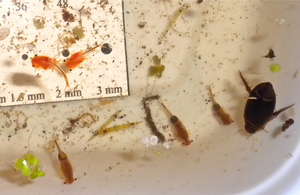Pondcast 14: Pregnant fairy shrimp avoid pond predators

Pond critters on April 10, 2010: One large, brown predaceous diving beetle, three phantom midge larvae, five fairy shrimp (two male, three female) and lots of small zooplankton (probably seed shrimp - look like tiny dots).
Stefan Szumko | Contributor
Out of town for a week, I was finally able to head back to the pond on Saturday evening, April 10, at sunset.
A few spring peepers were calling. The dogwood on the southeast corner of the pond was blooming. New and old species of aquatic organisms were observed.
It is now possible to differentiate between male and female fairy shrimp. The females are pregnant, as evidenced by their egg sacs. These freshwater shrimp, found exclusively in larger vernal pools containing no fish, have grown to about one centimeter in size. They’ll be around for only a few more weeks before they complete their life cycle. Then they’ll deposit their eggs, which will become buried in the mud to hatch next spring.
A single predaceous diving beetle was collected and can be seen hunting for zooplankton in this week's video. In Michigan, there have been at least 130 species of predaceous diving beetles identified. These beetles, of the family Dytiscidae, prefer living in still water - ponds, lakes, etc.
Beetles belong to the insect order Coleoptera, which means they have a hard pair of front wings to protect the back wings they use for flying. Since they can fly for long distances, the first predaceous diving beetle in Black Pond certainly arrived from another body of water.
Predaceous diving beetle larvae are also known as “water tigers,” possessing fierce-looking mandibles (jaws) they use to capture their prey. We’ll see these babies in future weeks. Upon reaching the pupal stage, the larvae will bury themselves in mud next to the pond for a week or two. Reaching adulthood, the predaceous diving beetle will return to the water and live for another three years or so.
Predaceous diving beetles and their larvae do bite and will even bite a human hand that holds them. Their digestive enzyme does cause an unpleasant sensation that lasts for several moments. So please use caution if you choose to handle one.
Additionally, these beetles will attempt to eat anything they can catch. In an enclosed space, such as a collection jar or sample tray, predaceous diving beetles will attempt to eat larger organisms, including salamander larvae or tadpoles. So please, keep these organisms separated.
Other aquatic species seen in Week 14 included: threadworms, phantom midge larvae, seed shrimp, one leech or other flatworm, an unidentified larva, water fleas (daphnia) and another type water beetle, small in size. Copepods (cyclops) were absent from the collection. Since they were pregnant in previous weeks, they must have completed their life cycle by laying eggs and then dying, becoming pond detritus.
As the evening turned from dusk into night, a pair of mallard ducks noisily splashed into the pond. Two or more raccoons were heard and then seen on the ground in the valley north of the pond. Here is a G-rated link with information about raccoons, sounds they make and videos of them in action. I decided that I really didn’t want to get in the way of a potential territorial dispute or mammalian mating session, so instead headed home.
Photo Caption:
Pond Critters on April 10, 2010: 1 large, brown predaceous diving beetle, 3 phantom midge larvae, 5 fairy shrimp (2 male, 3 female), and lots of small zooplankton (probably seed shrimp - look like tiny dots).
Stefan Szumko is a middle school science teacher by trade, an outdoor environmental educator by calling, and a homedaddy by choice. He can be reached at slugwhisperer@gmail.com. To read previous pondcast reports, click here. To view the entire Pondcast video series, click here.

